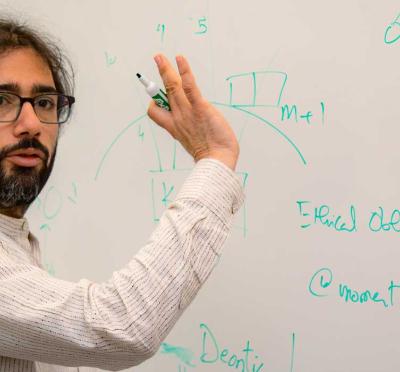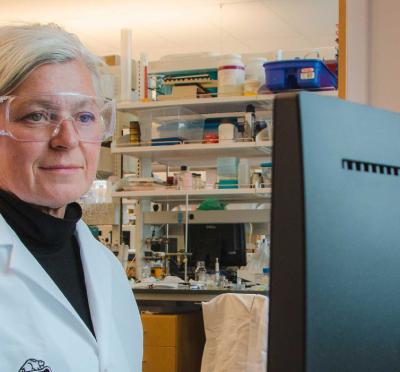Imagine someday you could have a backup copy of your heart or liver, grown from your own stem cells and ready to transplant, just waiting in cold storage should you ever need it. While that technology doesn’t yet exist, new research from the College of Engineering is paving the way toward a key prerequisite: The ability to preserve living tissues indefinitely.
Cryopreservation has long been used in simpler applications, such as the long-term storage of blood, reproductive cells, embryos, and plant seeds. But delicate tissues and the complex organs built from them can suffer critical damage when subjected to the deep freeze.
Thanks to work spearheaded by Adam Higgins, associate professor of bioengineering, medical science is a key step closer to the cryopreservation of brain slices, pancreatic cells — and, yes, even whole organs — courtesy of an innovative computer model.
“Cryopreservation of tissues would be useful for biomedical research and for transplantation medicine, but it’s difficult to cryopreserve tissues,” Higgins said. “One major reason is that ice crystals can break apart a tissue from the inside. Folks who cook are probably already familiar with this — a tomato that has been frozen and thawed becomes mushy.”
Vitrification, Higgins explains, is a cryopreservation strategy using compounds known as cryoprotectants, or CPAs, to prevent ice formation. One example is ethylene glycol, the same stuff used in automotive antifreeze. At sufficient concentrations, CPAs cause the water inside cells to solidify into a glassy state at liquid nitrogen temperatures (below -320 F), rather than form ice crystals. But vitrifying tissues isn’t as simple as just loading them up with antifreeze, Higgins says.
“The problem is that these chemicals can cause osmotic damage, due to water crossing cell membranes and causing the cells to burst,” Higgins said. “They can also kill cells due to toxicity. So, in designing the best vitrification method, the trick is choosing the best path between normal physiological conditions and a final vitrified state — that is, high CPA concentration and liquid nitrogen temperature.”
Hence the need for mathematical modeling. In earlier research involving a single layer of endothelial cells, which make up the lining of the circulatory system, Higgins and colleagues in the College of Engineering showed the value of a model that involved CPA toxicity, osmotic damage, and mass transfer. The modeling uncovered an unexpected approach for loading CPA: getting cells to swell.
The researchers found that if cells were initially exposed to a low CPA concentration and given time to swell, the sample could be vitrified after rapidly adding a high concentration. The upshot was much less overall toxicity, Higgins said. Healthy cell survival following vitrification rose to greater than 80%, up from about 10% with a conventional approach. The findings were published in Biophysical Journal.
“The biggest single problem and limiting factor in vitrification is CPA toxicity, and the swelling method was quite useful for addressing that,” he said. “Our new paper extends this line of research by presenting a new model of mass transfer in tissue. A key feature is that it allows for the prediction of tissue size changes.”

Ross Warner, Ph.D. chemical engineering ’20, was a research associate in Adam Higgins’ lab.
Higgins notes that there have been observations of multiple types of tissues changing size after exposure to CPA solutions. Among them are cartilage, ovarian tissue, and groups of cells in the pancreas known as islets. Those size changes will likely be important considerations for the design of tissue vitrification methods, he said.
“The conventional mass transfer modeling approach, known as Fick’s law, assumes tissue size remains constant,” Higgins said. “Our new model, which we used for two very different types of tissues, articular cartilage and pancreatic islets, opens the door to extending our previous approach to the design of better methods for the cryopreservation of various tissue types.”
When vitrification of increasingly complex tissues is possible, new applications are likely to become feasible, Higgins said — especially as progress continues in the quickly advancing field of tissue regeneration, in which stem cells can be used to grow new tissues or even whole organs.
Conceivably, tissues could be made in small amounts and stored until needed for transplantation. Organs donated for transplants could be routinely preserved until a precise immunological match is found. It’s also not outside the realm of possibility, Higgins said, that people could one day have a second heart, liver, kidney, pancreas, or any other organ grown from their own stem cells and vitrified for future use.
Drug development is another area that would benefit from improved and expanded vitrification potential. Drug testing typically occurs within cell culture systems or in animal models, which often don’t accurately predict a drug’s effects in people. New “organ on a chip” devices — with microfluidic chambers containing cultured human cells to mimic tissues or organs — might be able to more accurately forecast drug responses in people, but their use necessitates long-term storage of cells.
Collaborating with Higgins were Ross Warner, a research associate at Oregon State, Ali Eroglu of Augusta University in Georgia, and Robyn Shuttleworth and James Benson of the University of Saskatchewan. The National Institutes of Health provided funding for the research.



